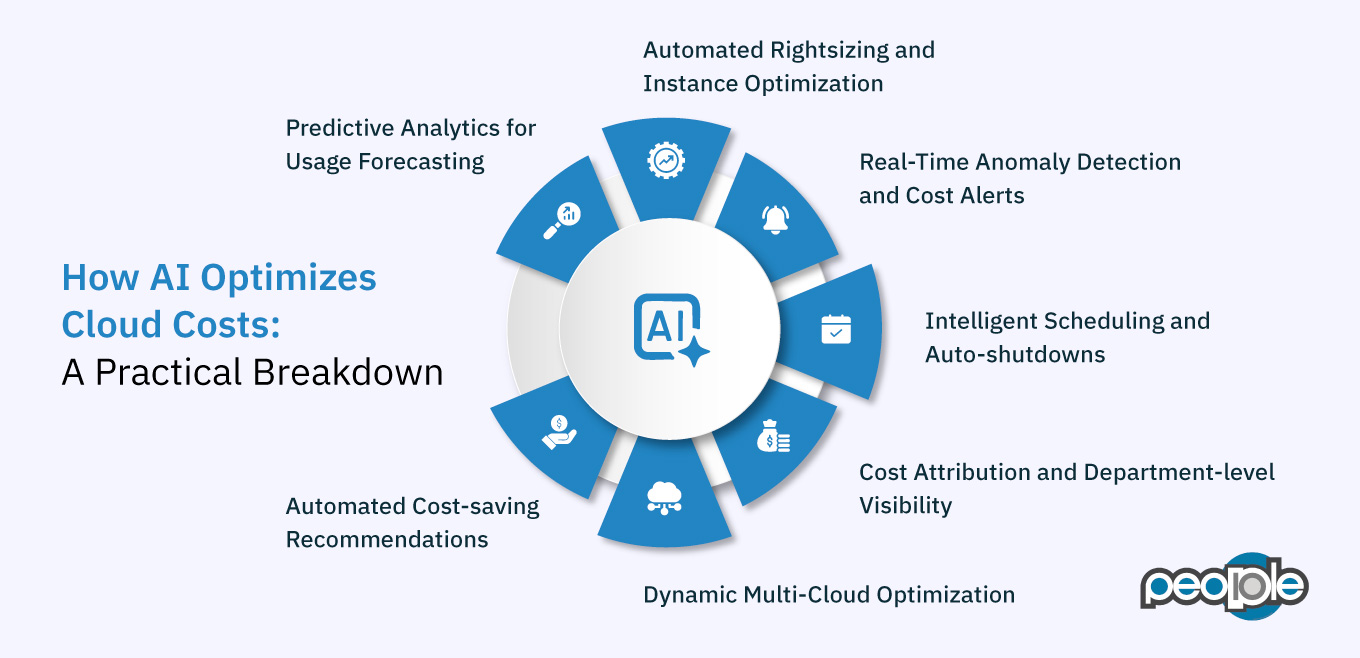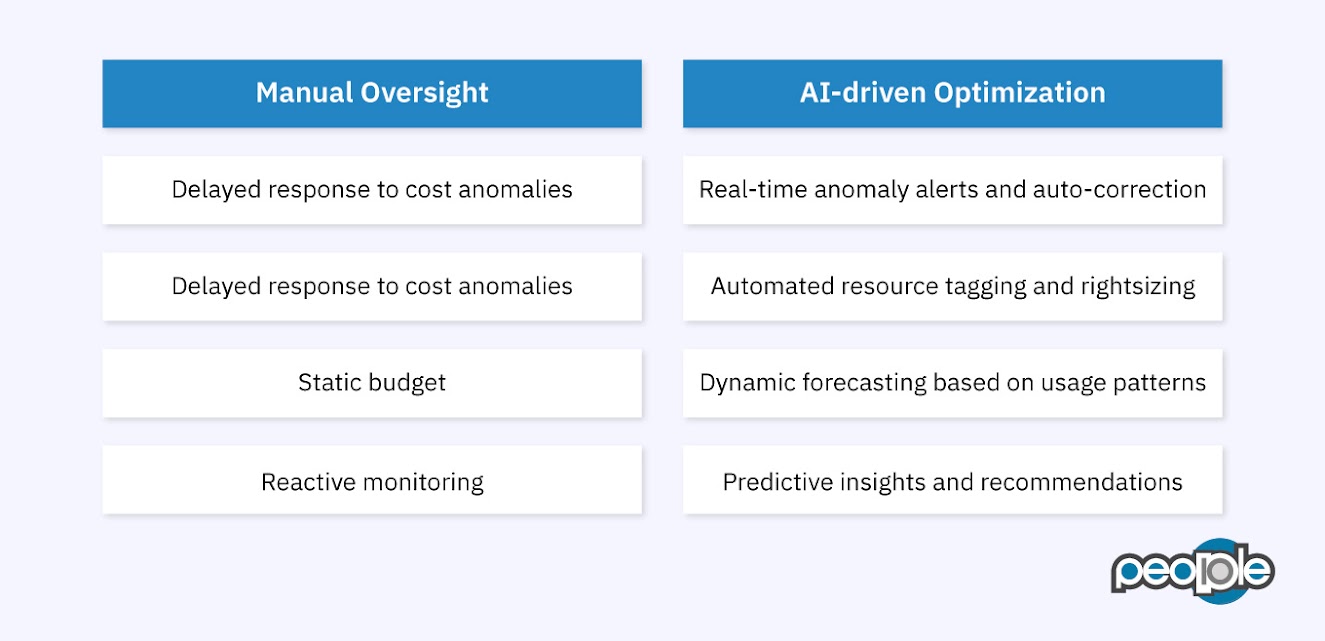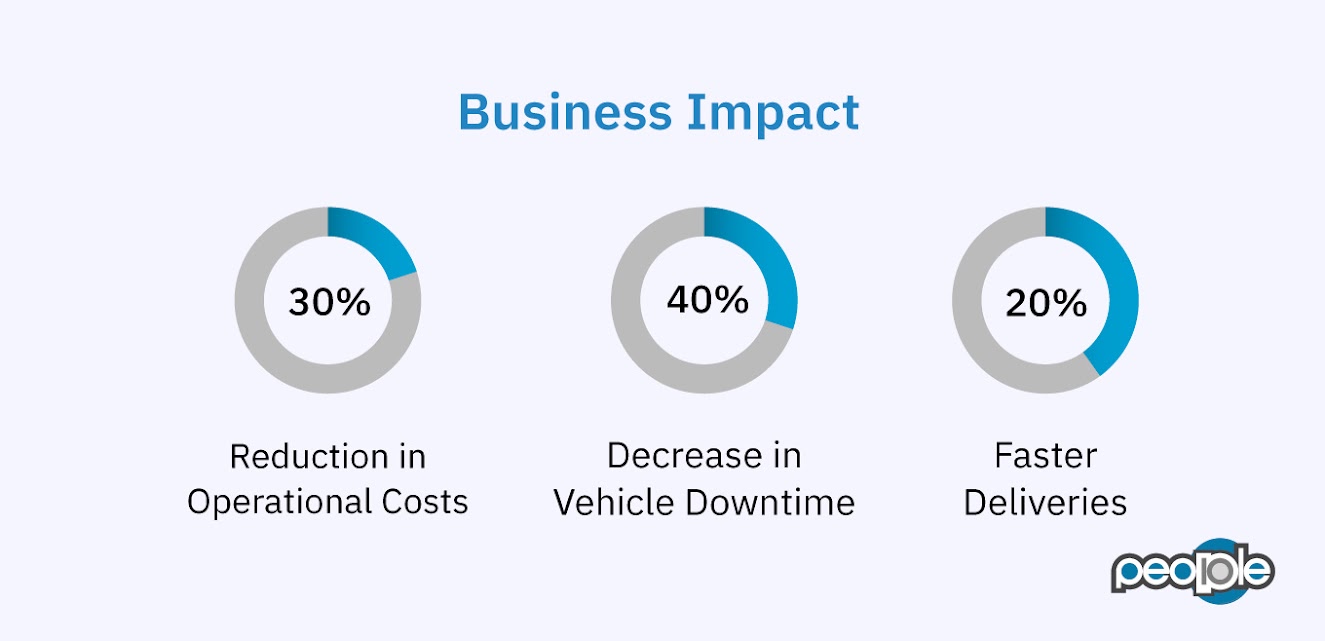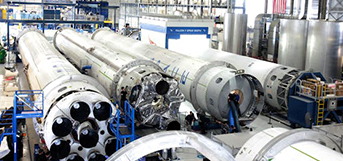As we help enterprises scale their cloud environments, we consistently see cost management challenges become strategic, not just operational, imperatives. For today’s CIOs and CTOs, every cloud dollar must be accountable, agile, and aligned to business growth. At People10 Technologies, we make that happen by transforming AI for cloud cost optimization into a value-driving discipline.
AI in enterprise IT is changing that narrative. At People10 Technologies, we architect and operationalize AI cost management platforms that go beyond reporting. They enable predictive insight, real-time optimization, and the kind of intelligent automation that drives down waste and aligns cloud spend directly with business priorities.
In this blog, we will explore how AI is transforming cloud cost optimization and resource allocation.
Why Cloud Costs Spiral Out of Control
Enterprises turn to the cloud for agility and speed—but unless cost governance is built in from day one, spending quickly spirals out of control. People10 Technologies continues to help clients uncover the root causes: idle instances, oversized resources, delayed visibility, and fragmented ownership. Our delivery model prioritizes governance, automation, and financial transparency at every step.
According to industry benchmarks, 32% of cloud spend is wasted on non-strategic consumption. Key drivers include:
- Idle resources are left running long after their usefulness
- Oversized compute instances that exceed real-time usage needs
- Delayed, manual billing reviews that catch cost anomalies too late
- Fragmented workload visibility across environments and teams
- Inaccurate forecasting, resulting in budget shortfalls and overprovisioning
In our delivery experience, legacy cost tools are reactive—they leave resources idle, fragment usage across teams, and miss the big picture on savings. Our approach replaces this with real-time, AI-driven visibility and proactive automation that closes the gap before waste ever occurs.
AI-powered cloud cost optimization leverages automation and predictive insights to identify anomalies, optimize usage, and align spending with business objectives.
How AI Optimizes Cloud Costs: A Practical Breakdown

Cloud infrastructure offers tremendous flexibility, but without precision, it becomes one of the biggest operational cost centers. Manual oversight and fragmented visibility make it hard for enterprise leaders to control spending effectively across hybrid and multi-cloud environments.
AI changes that.
Embedding generative AI in cloud governance enables real-time insights, precision forecasting, and continuous optimization for proactive cloud cost control.
Here is how AI in enterprise IT turns cloud cost challenges into measurable business outcomes:
1. Predictive Analytics for Usage Forecasting
Implementing advanced AI forecasting models that learn from historical patterns, peak usage, and build business seasonality. It has empowered our clients to anticipate demand, rightsize proactively, and eliminate costly over-provisioning. AI simplifies this through:
- Analyzing usage history to predict future demand
- Learning patterns from seasonal and peak behaviors
- This helps teams predict usage, plan smartly, and prevent over-provisioning. You are no longer reacting. You are shaping cloud costs proactively.
Did you know?
Our delivery teams at People10 architect and deploy AI-driven forecasting solutions. Our partnership with a leading manufacturer slashed their inventory costs by 20% while boosting operational agility by 30%.
2. Automated Rightsizing and Instance Optimization
Deploying machine learning-driven rightsizing engines enables you to constantly monitor usage data and recommend optimal compute and storage configurations. It can trigger auto-scaling to ensure the infrastructure matches real demand at every moment, not just in static review cycles.
Machine learning algorithms continuously analyze resource utilization metrics to recommend:
- Downsizing oversized compute instances
- Switching to cheaper storage tiers without affecting performance
- Terminating idle VMs or containers
These recommendations adapt in near real-time, ensuring infrastructure is always aligned with actual workload demand.


3. Real-Time Anomaly Detection and Cost Alerts
With AI-powered anomaly detection, you are equipped with real-time cost intelligence, enabling you to receive immediate alerts and automated interventions before overspend can escalate. This proactive control is now built into every solution we deliver for multi-team, multi-cloud environments.
- Detects unusual usage patterns across services
- Triggers automated alerts or actions to mitigate overspend
- Differentiates between organic scaling and wasteful consumption
Such proactive control is especially critical in multi-team environments where multiple stakeholders independently deploy and consume resources.
4. Intelligent Scheduling and Auto-shutdowns
Integrating AI-driven scheduling into your delivery pipelines enables non-production environments to power down automatically during idle periods. It drives savings and operational discipline without requiring additional manual effort from engineering teams.
AI-powered schedulers use historical usage data and behavioral patterns to:
- Automatically shut down dev/test environments during idle hours
- Power-up services just in time for workflows or business operations
- Apply usage windows and cooldown periods dynamically
This eliminates unnecessary runtime costs without relying on static scripts or manual toggles.
5. Cost Attribution and Department-level Visibility
While developing custom cost attribution platforms, you can leverage machine learning and NLP to accurately map usage and spending to every department, project, and cost center. It gives your finance, IT, and business leaders granular visibility and the confidence to drive accountable growth. Building this with AI simplifies it further by:
- Mapping usage to individual cost centers
- Automating tagging enforcement using NLP and ML-based inference
- Recommending budget adjustments based on consumption behavior
The result is granular visibility and better financial governance across business units.
6. Dynamic Multi-Cloud Optimization
As more enterprises adopt hybrid and multi-cloud strategies, leveraging AI for real-time workload placement—evaluating provider pricing, latency, and historical performance to ensure every deployment maximizes cost-effectiveness and business value, regardless of the underlying cloud. AI models can evaluate:
- Real-time pricing differences across cloud vendors
- Data egress costs, latency, and workload affinity
- Historical performance-to-cost ratios
This ensures enterprises maintain a cost-performance balance across a distributed cloud ecosystem.
7. Automated Cost-saving Recommendations
Modern AI-powered platforms don’t just report—they prescribe. You need systems that surface actionable, real-time recommendations, from reserved instance purchases to workload shifting, helping clients capture savings continuously, not just during quarterly reviews. They recommend action:
- Suggest reserved instance purchases or savings plans
- Highlight better-fit instance types or container configurations
- Recommend workload shifts to spot instances or less expensive regions
These insights are actionable, timely, and tailored to the environment, driving continuous optimization at scale.
AI is no longer a “nice-to-have” in cloud cost management; it is a strategic lever for enterprise optimization. It enables organizations to move from manual tracking to intelligent automation, from delayed reports to real-time action, and from overspending to measurable efficiency.
With the right AI-powered strategy, cloud infrastructure becomes not just scalable but financially predictable, accountable, and aligned with business priorities.
AI-driven Resource Allocation: From Reactive Scaling to Intelligent Provisioning
You can elevate your resource allocation from a static process to a dynamic, AI-powered capability, enabling infrastructure to anticipate demand, scale automatically, and respond to business events in real-time. This shift allows your organization to transition from reactive scaling to intelligent, autonomous provisioning.
Static provisioning models and manual scaling policies are no match for today’s elastic workloads. They lead to either:
- Over-provisioning during low-demand periods (wasting resources), or
- Under-provisioning during traffic spikes (impacting performance and availability)
AI in enterprise fundamentally changes this by bringing predictive intelligence and autonomous control to the allocation process.
How AI Powers Dynamic Resource Allocation
1. Predictive Workload Modeling
AI algorithms analyze usage history, performance metrics, and business patterns to accurately forecast demand. This allows infrastructure teams to provision resources just in time, not just in case.
2. Real-time Optimization
AI systems monitor workloads and system health in real-time. Based on live metrics, they scale infrastructure up or down automatically, without waiting for human triggers or predefined thresholds.
3. Pattern Recognition for Strategic Efficiency
By identifying trends across workloads, time zones, and departments, AI exposes recurring inefficiencies. This enables more intelligent decisions on resource distribution across projects and environments.
4. External Signal Integration
Advanced AI models also consider external triggers, such as scheduled deployments, campaign launches, or business seasonality, to fine-tune provisioning beyond just internal metrics.
Real-world AI in Action: Driving Cost and Efficiency Gains in Fleet Management


AI is not just theoretical, but it is driving measurable transformation across industries. One such example is fleet management in logistics.
When we engineered a fleet management platform for a global logistics client, our delivery teams combined predictive analytics, real-time optimization, and dynamic scheduling. The results were immediate: delivered through an AI-powered, cloud-native system, we continue to evolve alongside our clients.
The goal: Minimize operational costs while maximizing delivery efficiency.
The solution: We built an AI-powered fleet management platform that dynamically allocates resources, predicts maintenance needs, and optimizes routing automatically and continuously.


Want to know the full story?
Download the case study to explore how we built this scalable, cost-efficient fleet management platform from the ground up.
The Road Ahead: AI-Powered Cloud Optimization at Enterprise Scale
Our experience with 200+ clients shows that traditional cost-cutting methods alone don’t scale in a flexible, multi-cloud environment. At People10 Technologies, we help enterprises move beyond reactive spend control to a future where AI powers continuous optimization, financial predictability, and business-aligned cloud growth.
As cloud ecosystems expand, the question is not whether you are spending too much; it is whether you are spending smart. Traditional cost-cutting methods no longer scale in today’s dynamic, multi-cloud environments. AI is the differentiator.
When implemented correctly, AI for cloud computing not only optimizes, but also transforms. It answers a critical question for CIOs and CTOs:
Is cloud truly cost-effective at scale?
With AI-driven strategies, the answer is a measurable yes.
The People10 Advantage in AI-Driven Cloud Solutions
- Cloud & AI Expertise Combined: We merge deep cloud-native engineering with AI/ML automation to reduce IT wastage, boost performance, and enable agile operations.
- Custom Cost Intelligence Platforms: We build tailored platforms that deliver real-time visibility, predictive analytics, and automated optimizations aligned with your key performance indicators (KPIs).
- Cloud-agnostic, Outcome-focused: From AWS to Azure to GCP, we remain vendor-neutral, focusing entirely on what drives business results.
Why Enterprises Choose People10 for AI-based Cloud Optimization
AI-Driven Cloud Engineering at Its Core
At People10 Technologies, our engineering leadership blends deep domain expertise with hands-on delivery experience. We don’t just consult—we build, we optimize, and we own the outcomes, supporting your teams from design through continuous improvement. Our focus is always on measurable impact and long-term success.
Custom-Built Cost Intelligence Platforms
No off-the-shelf dashboards. We deliver tailored platforms that combine predictive analytics, real-time anomaly detection, and automated rightsizing, aligned with your business KPIs and financial goals.
Cloud-Agnostic. Outcome-Obsessed
Whether on AWS, Azure, or GCP, we remain provider-neutral, driven solely by what maximizes efficiency, resilience, and return on investment (ROI) for your enterprise.
Cut Cloud Costs by 30%, Just Like Leading Enterprises Did
Let’s schedule a strategy session with our delivery leaders if you are ready to turn cloud cost control into a competitive advantage. This isn’t just about cost—it’s about freeing up budget for innovation and new growth projects.
Author
Mohit Juneja leverages his extensive expertise in architecture and solution design to drive complex application delivery. His passion for continuous learning keeps him at the forefront of technology advancements.




